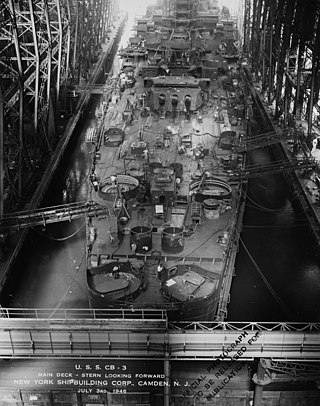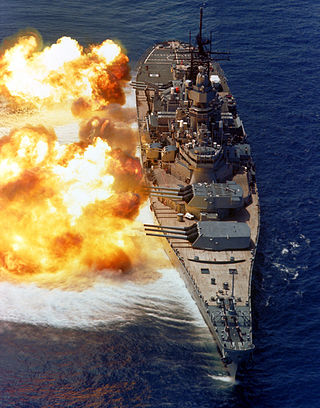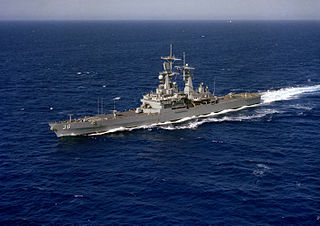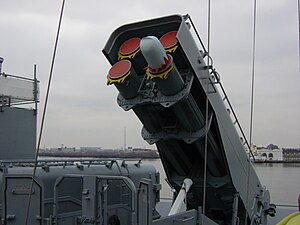
A cruiser is a type of warship. Modern cruisers are generally the largest ships in a fleet after aircraft carriers and amphibious assault ships, and can usually perform several operational roles from search-and-destroy to ocean escort to sea denial.

The BGM-109 TomahawkLand Attack Missile (TLAM) is an American long-range, all-weather, jet-powered, subsonic cruise missile that is primarily used by the United States Navy and Royal Navy in ship and submarine-based land-attack operations.

USS Missouri (BB-63) is an Iowa-class battleship built for the United States Navy (USN) in the 1940s and is a museum ship. Completed in 1944, she is the last battleship commissioned by the United States. The ship was assigned to the Pacific Theater during World War II, where she participated in the Battles of Iwo Jima and Okinawa and shelled the Japanese home islands. Her quarterdeck was the site of the surrender of the Empire of Japan, which ended World War II.

USS New Jersey (BB-62) is an Iowa-class battleship, and was the second ship of the United States Navy to be named after the U.S. state of New Jersey. She was often referred to fondly as "Big J". New Jersey earned more battle stars for combat actions than the other three completed Iowa-class battleships, and was the only US battleship used to provide gunfire support during the Vietnam War.

USS Kentucky (BB-66) was an uncompleted battleship intended to be the last ship of the Iowa class. Hull BB-66 was originally to be the second ship of the Montana-class battleships. However, the urgent need for more warships at the outbreak of World War II and the U.S. Navy's experiences in the Pacific theater led it to conclude that rather than battleships larger and more heavily armed than the Iowa class, it quickly needed more fast battleships of that class to escort the new Essex-class aircraft carriers being built. As a result, hulls BB-65 and BB-66 were reordered and laid down as Iowa-class battleships in 1942.

USS Wisconsin (BB-64) is an Iowa-class battleship built for the United States Navy (USN) in the 1940s and is currently a museum ship. Completed in 1944, the ship was assigned to the Pacific Theater during World War II, where she participated in the Philippines campaign and the Battles of Iwo Jima and Okinawa. The battleship shelled the Japanese home islands shortly before the end of the war in September 1945. During the Korean War, Wisconsin shelled North Korean targets in support of United Nations and South Korean ground operations, after which she was decommissioned. She was reactivated in 1986; after a modernization program, she participated in Operation Desert Storm in January – February 1991.

USS Hawaii (CB-3) was intended to be the third member of the Alaska-class large cruisers. It was the first United States Navy ship to be named after the then-Territory of Hawaii. Because Hawaii's construction was delayed by higher-priority ships like aircraft carriers, her keel was not laid until December 1943, about two years after her sister ship Guam.

A warship or combatant ship is a ship that is used for naval warfare. Usually they belong to the navy branch of the armed forces of a nation, though they have also been operated by individuals, cooperatives and corporations. As well as being armed, warships are designed to withstand damage and are typically faster and more maneuverable than merchant ships. Unlike a merchant ship, which carries cargo, a warship typically carries only weapons, ammunition and supplies for its crew.

The Iowa class was a class of six fast battleships ordered by the United States Navy in 1939 and 1940. They were initially intended to intercept fast capital ships such as the Japanese Kongō class and serve as the "fast wing" of the U.S. battle line. The Iowa class was designed to meet the Second London Naval Treaty's "escalator clause" limit of 45,000-long-ton (45,700 t) standard displacement. Beginning in August 1942, four vessels, Iowa, New Jersey, Missouri, and Wisconsin, were completed; two more, Illinois and Kentucky, were laid down but canceled in 1945 and 1958, respectively, before completion, and both hulls were scrapped in 1958–1959.

The Alaska-class were six large cruisers ordered before World War II for the United States Navy (USN), of which only two were completed and saw service late in the war. The USN designation for the ships of this class was 'large cruiser' (CB), a designation unique to the Alaska-class, and the majority of leading reference works consider them as such. However, various other works have alternately described these ships as battlecruisers despite the USN having never classified them as such, and having actively discouraged the use of the term in describing the class. The Alaskas were all named after territories or insular areas of the United States, signifying their intermediate status between larger battleships and smaller heavy and light cruisers.

The Spruance-class destroyer was developed by the United States to replace the many World War II–built Allen M. Sumner- and Gearing-class destroyers, and was the primary destroyer built for the United States Navy during the 1970s and 1980s. It was named in honor of U.S. Navy Admiral Raymond A. Spruance, who successfully led major naval battles in the Asiatic-Pacific Theater during World War II such as the Battle of Midway and the Battle of the Philippine Sea.

The Baltimore-class heavy cruisers were a class of heavy cruisers in the United States Navy commissioned during and shortly after World War II. Fourteen Baltimores were completed, more than any other class of heavy cruiser, along with another three ships of the Oregon City sub-class. The Baltimores also were the first cruisers in the US Navy to be designed without the limitations of the London Naval Treaty.

The Virginia class were four nuclear-powered, guided-missile cruisers that served in the United States Navy until the mid-to-late 1990s. The double-ended cruisers were commissioned between 1976 and 1980. They were the final class of nuclear-powered cruisers completed and the last ships ordered as Destroyer Leaders under the pre-1975 classification system.

The Iowa-class battleships are the most heavily armed warships the United States Navy has ever put to sea, due to the continual development of their onboard weaponry. The first Iowa-class ship was laid down in June 1940; in their World War II configuration, each of the Iowa-class battleships had a main battery of 16-inch (406 mm) guns that could hit targets nearly 20 statute miles (32 km) away with a variety of artillery shells designed for anti-ship or bombardment work. The secondary battery of 5-inch (127 mm) guns could hit targets nearly 9 statute miles (14 km) away with solid projectiles or proximity fuzed shells, and was effective in an anti-aircraft role as well. Each of the four battleships carried a wide array of 20 mm and 40 mm anti-aircraft guns for defense against enemy aircraft.

JDS Mirai (DDH-182) is a fictional helicopter defense destroyer of the Japan Maritime Self-Defense Force (JMSDF), created for the Japanese manga and anime series Zipang. The central point of the plot of the anime is that the modern warship Mirai is transported back sixty years through time to 1942 on the eve of the Battle of Midway. The ship's weapons alone are enough to change the course of World War II, but equally potent are the advanced technology and knowledge of future events on board. The name of the ship is a homophone for the Japanese word meaning "future" and is often the basis of double entendres in the anime. The phrase "Mirai no nipponjin" (みらいの日本人), often repeated in the anime, for example, can mean "Japanese people of the ship Mirai" or "Japanese people of the future."

The aircraft cruiser is a warship that combines the features of the aircraft carrier and a surface warship such as a cruiser or battleship.

The United States battleship retirement debate was a debate among the United States Navy, Marine Corps, Congress, and independent groups over the effectiveness of naval gunfire support (NGFS) provided by Iowa-class battleships, and whether an alternative should be implemented. The debate centered on the best way to provide fire support for amphibious assault and other troops near a shoreline.

Ship gun fire-control systems (GFCS) are analogue fire-control systems that were used aboard naval warships prior to modern electronic computerized systems, to control targeting of guns against surface ships, aircraft, and shore targets, with either optical or radar sighting. Most US ships that are destroyers or larger employed gun fire-control systems for 5-inch (127 mm) and larger guns, up to battleships, such as Iowa class.

SMS Budapest was a Monarch-class coastal defense ship built for the Austro-Hungarian Navy in the 1890s. After their commissioning, Budapest and the two other Monarch-class ships made several training cruises in the Mediterranean Sea in the early 1900s. Budapest and her sisters formed the 1st Capital Ship Division of the Austro-Hungarian Navy until they were replaced by the newly commissioned Habsburg-class pre-dreadnought battleships at the turn of the century. In 1906 the three Monarchs were placed in reserve and only recommissioned during the annual summer training exercises. After the start of World War I, Budapest was recommissioned and assigned to 5th Division together with her sisters.

The Mark 41 vertical launching system is a shipborne missile canister launching system which provides a rapid-fire launch capability against hostile threats. The vertical launching system (VLS) concept was derived from work on the Aegis Combat System.




















